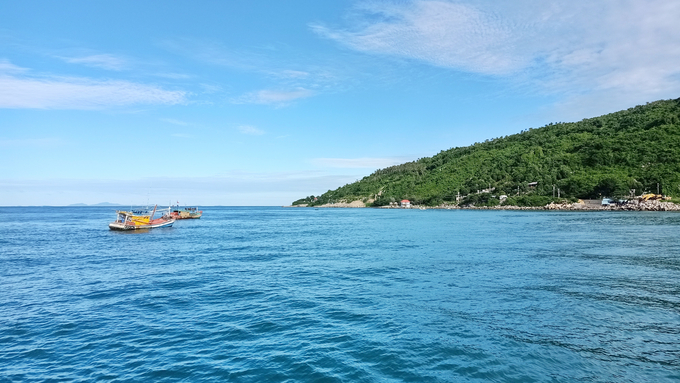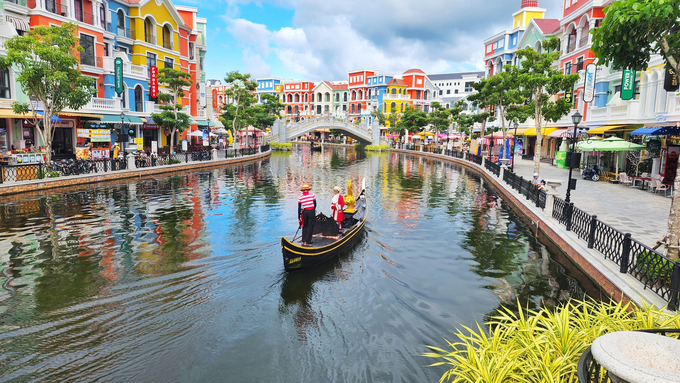May 22, 2025 | 01:40 GMT +7
May 22, 2025 | 01:40 GMT +7
Hotline: 0913.378.918
May 22, 2025 | 01:40 GMT +7
Hotline: 0913.378.918
Kien Giang is one of 28 provinces and cities in Vietnam that have sea and coastal areas with a rich and diverse mangrove ecosystem. Besides, the province also has potential land, hills, minerals, primeval forests, sea areas, and islands.

Kien Giang province is the locality with the largest sea area in the Mekong Delta with an area of nearly 63,300 square kilometers. Photo: Kim Anh.
At the same time, this is also the locality with the largest sea area in the Mekong Delta, with an area of nearly 63,300 km2. Additionally, the 200km long coastline and more than 140 large and small floating islands form prime locations. This is the driving force for the region's marine economic development.
Recently, Kien Giang province has issued many programs and plans for marine economic development, which focus on developing offshore fishing in association with the protection of aquatic resources. Notably: The sustainable oriented marine aquaculture development project to 2030 or the Project on Investigation of fishing activities in coastal and coastal waters in the province. These practices have contributed to bringing the province's fishing output to about 600,000 tons/per year.
Mr. Nguyen Thanh Nhan, Vice Chairman of Kien Giang Provincial People's Committee excitedly said that the province's seafood current production has accounted for 16% of the country's total output and over 40% of the Mekong Delta region's output. Moreover, the seafood processing sector is also increasingly focused on product diversification. The province currently has 88 seafood processing factories with modern technological production lines, with a total capacity of 250,000 tons/year.
Another statistic given by Mr. Nhan to demonstrate the speed of marine economic development in Kien Giang is the success of mobilizing investment resources. In the period 2011 - 2015, the province mobilized over VND111,000 billion to develop the sea-island area. By the period 2016-2020, the number increased to VND140,000 billion. In addition, many irrigations work in the coastal area for aquaculture, strengthening sea dykes works, and 8 urgent projects to respond to climate change have been implemented and are under construction. Consequently, the economic infrastructure of the sea and islands of Kien Giang province has prospered, and production types and industries are diversified.
Especially, Kien Giang's marine economy has a strong development thanks to the tourism sector. Phu Quoc City, the first island city in Vietnam, received investments in a synchronous transport, electricity, and water supply system. Many high-class hotels, resorts, and large entertainment areas have been built. The number of tourists to Kien Giang since 2015 has reached 40.8 million. This brings in total revenue of over VND70,000 billion.

Since 2015, the number of tourists to Kien Giang has reached 40.8 million, bringing in revenue of over 70,000 billion VND. Photo: Kim Anh.
In the orientation of developing the Kien Giang marine economy to 2030, with a vision to 2045, Mr. Nguyen Thanh Nhan affirmed that the province will closely coordinate with localities in the Southwestern sea and coastal areas to develop targets. The province will also aim for sustainable economic development, ensuring regional and inter-local connectivity.

According to the Strategy for sustainable development of Vietnam's marine economy to 2030, with a vision to 2045, Kien Giang province is determined to become a national marine economic center. Photo: Kim Anh.
At the same time, the province also carries out urban upgrading and development projects in areas with a high risk of climate change's impact. Particularly in Phu Quoc City, the province will pilot urban planning and urban development programs for the city in association with major marine economic centers. The goal is to turn Phu Quoc City into an important marine economic development leader in the national marine space.
With the support from international organizations, Mr.Nhan believes that this will make Phu Quoc city an urban model with a synchronous and intelligent technical infrastructure system, responding to climate change and sustainability. According to the Strategy for sustainable development of Vietnam's marine economy to 2030, with a vision to 2045, Kien Giang province is determined to become a national marine economic center. The province will turn Phu Quoc City into a strong and international marine eco-tourism and service center. This goal is also consistent with the development orientation expressed in the Master Plan for the Mekong Delta region in the period of 2021 - 2030 approved by the Prime Minister.
Translated by Hoang Duy
![Reducing emissions from rice fields: [2] Farmers’ commitment to the soil](https://t.ex-cdn.com/nongnghiepmoitruong.vn/608w/files/news/2025/05/05/dsc08881jpg-nongnghiep-140632.jpg)
(VAN) Clean rice cultivation model in Thuong Tan commune, Bac Tan Uyen district, is assisting local residents in achieving sustainable agriculture by substantially reducing costs, increasing productivity, and protecting the environment.

(VAN) At the conference to disseminate Resolution No. 68, AgriS introduced its digital agricultural ecosystem and reaffirmed its commitment to accompanying the Government in promoting private sector development and sustainable agriculture.

(VAN) 'Blue Ocean - Blue Foods' initiative is designed to restore marine ecosystems and establish sustainable livelihoods for local communities by cultivating a minimum of 1,000 hectares of cottonii seaweed in the first three years.
/2025/05/21/4642-3-112707_603.jpg)
(VAN) The V-SCOPE project has made direct contributions to three out of six pillars of the Comprehensive Strategic Partnership between Vietnam and Australia.

(VAN) Facing the threat of rabies spreading to the community, Gia Lai province urgently carries out measures to vaccinate dogs and cats on a large scale.

(VAN) Disease-free livestock farming not only protects livestock herds but also stabilizes production and livelihoods for many farmers in Tuyen Quang.

(VAN) Japan's grant aid project contributes to capacity building, promoting organic agricultural production, and fostering sustainable community development in Dong Thap province.